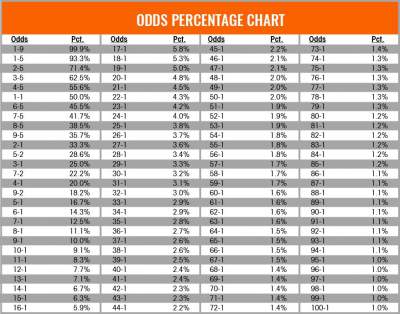1 4 Odds In Decimal


To convert decimal odds to fractional odds, you need to do the reverse. This means positioning the decimal number as the numerator and 1 as the denominator. You then multiply the top and bottom numbers by ten until there are no decimal places left. For example, to convert odds of 1.4, you do the following: 1.4 – 1 = 0.4. Convert Decimal to Fractional. Decimal = Fractional + 1. You can try it in the calculator above. There are two kind: +Positive(Underdog team) And Negative(favorite team), and the ratio is based on a stack of 100 units. If the odds are positive +250. Here’s an example: The Stars are 1.714 in decimal odds (-140 in American). For every $1 wagered, the bettor profits 71.4 cents, plus the original stake of $1. The Oilers have odds of 2.2 in decimal odds (+120 in American), which means every $1 bet would profit $1.20 plus the original $1 stake.
- 4/1 as a decimal - solution and the full explanation with calculations. Below you can find the full step by step solution for you problem. We hope it will be very helpful for you and it will help you to understand the solving process. If it's not what You are looking for, type in.
- Thus even odds 1/1 are quoted in decimal odds as 2.00. The 4/1 fractional odds discussed above are quoted as 5.00, while the 1/4 odds are quoted as 1.25. This is considered to be ideal for parlay betting, because the odds to be paid out are simply the product of the odds for each outcome wagered on.
Implied probability is basically the conversion of odds into a percentage. That percentage then shows the likelihood of an outcome happening based on the size of the odds. High odds suggest a low probability of something happening, while low odds suggest a high probability of something happening.

For example, imagine a tennis player is +200 to win an upcoming match. This would be 3.00 in decimal odds, and 2/1 in fractional odds. The implied probability for these odds is 33.33%. In this example, the odds suggest that the player has a 33.33% chance of winning the match.

1 4' In Decimal Form
In sports, the probability of something happening is usually subjective. There are several factors to take into account and there’s always a chance of the unexpected. No one can state definitively the exact probability of a player or team winning a game they’re taking part in. There’s an element of personal opinion involved.
Calculating the implied probability is useful though. It helps us decide whether or not we think a bet offers any positive value. We should always look for positive value when betting, and it exists when our estimated probability of an outcome happening is greater than the implied probability that the odds on that outcome suggest.
Confused? Don’t worry! It’s not as complicated as it may seem. To make this easier to understand, let’s continue with the example of the tennis player at +200 to win his match. As we’ve said, the implied probability here is 33.33%. So if we think that the player has a GREATER than 33.33% of winning, then it makes perfect sense to bet on him. If we think his chances are less than 33.33%, it’s wise not to bet on him.
If you’d like a more complete explanation on this subject, there’s an article in our sports betting guide that explains value and implied probability in further detail.
77 1 4% As Decimal
By convention only a set of fractions are used in fractional odds betting markets. The set does not include exact mathematical equivalents to all possible decimal and American odds. We use the closet fraction that is used in betting markets.
For example, the exact mathematical equivalent of decimal odds 30 is fractional odds 29/1. However 29/1 is not used in betting markets, instead 30/1 is used, so that is what appears in this converter.
1/4 Odds In Decimal
For an explanation of the odds types on this table see decimal, fractional and American odds. To find out what the numbers really represent see understand odds as probability with overround.